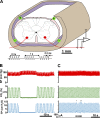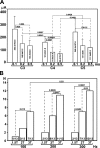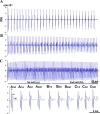Paced breathing and phrenic nerve responses evoked by epidural stimulation following complete high cervical spinal cord injury in rats
- PMID: 29771608
- PMCID: PMC6734078
- DOI: 10.1152/japplphysiol.00895.2017
Paced breathing and phrenic nerve responses evoked by epidural stimulation following complete high cervical spinal cord injury in rats
Abstract
Spinal cord injury (SCI) at the level of cervical segments often results in life-threatening respiratory complications and requires long-term mechanical ventilator assistance. Thus restoring diaphragm activity and regaining voluntary control of breathing are the primary clinical goals for patients with respiratory dysfunction following cervical SCI. Epidural stimulation (EDS) is a promising strategy that has been explored extensively for nonrespiratory functions and to a limited extent within the respiratory system. The goal of the present study is to assess the potential for EDS at the location of the phrenic nucleus (C3-C5) innervating the diaphragm: the main inspiratory muscle following complete C1 cervical transection. To avoid the suppressive effect of anesthesia, all experiments were performed in decerebrate, C1 cervical transection, unanesthetized, nonparalyzed ( n = 13) and paralyzed ( n = 7) animals. Our results show that C4 segment was the most responsive to EDS and required the lowest threshold of current intensity, affecting tracheal pressure and phrenic nerve responses. High-frequency (200-300 Hz) EDS applied over C4 segment (C4-EDS) was able to maintain breathing with normal end-tidal CO2 level and raise blood pressure. In addition, 100-300 Hz of C4-EDS showed time- and frequency-dependent changes (short-term facilitation) of evoked phrenic nerve responses that may serve as a target mechanism for pacing of phrenic motor circuits. The present work provides the first report of successful EDS at the level of phrenic nucleus in a complete SCI animal model and offers insight into the potential therapeutic application in patients with high cervical SCI. NEW & NOTEWORTHY The present work offers the first demonstration of successful life-supporting breathing paced by epidural stimulation (EDS) at the level of the phrenic nucleus, following a complete spinal cord injury in unanesthetized, decerebrate rats. Moreover, our experiments showed time- and frequency-dependent changes of evoked phrenic nerve activity during EDS that may serve as a target mechanism for pacing spinal phrenic motor networks.
Keywords: breathing; complete spinal cord injury; epidural stimulation; phrenic nerve; rats.
Conflict of interest statement
No conflicts of interest, financial or otherwise, are declared by the authors.
Figures






Similar articles
-
Pharmacological disinhibition enhances paced breathing following complete spinal cord injury in rats.Respir Physiol Neurobiol. 2020 Nov;282:103514. doi: 10.1016/j.resp.2020.103514. Epub 2020 Aug 1. Respir Physiol Neurobiol. 2020. PMID: 32750492 Free PMC article.
-
High-frequency epidural stimulation across the respiratory cycle evokes phrenic short-term potentiation after incomplete cervical spinal cord injury.J Neurophysiol. 2017 Oct 1;118(4):2344-2357. doi: 10.1152/jn.00913.2016. Epub 2017 Jun 14. J Neurophysiol. 2017. PMID: 28615341 Free PMC article.
-
Intraspinal microstimulation and diaphragm activation after cervical spinal cord injury.J Neurophysiol. 2017 Feb 1;117(2):767-776. doi: 10.1152/jn.00721.2016. Epub 2016 Nov 23. J Neurophysiol. 2017. PMID: 27881723 Free PMC article.
-
[The clinic experience of implantable diaphragm pacer in a patient with high cervical spinal cord injury and literature review].Zhonghua Jie He He Hu Xi Za Zhi. 2018 Sep 12;41(9):718-723. doi: 10.3760/cma.j.issn.1001-0939.2018.09.013. Zhonghua Jie He He Hu Xi Za Zhi. 2018. PMID: 30196606 Review. Chinese.
-
Functional recovery after cervical spinal cord injury: Role of neurotrophin and glutamatergic signaling in phrenic motoneurons.Respir Physiol Neurobiol. 2016 Jun;226:128-36. doi: 10.1016/j.resp.2015.10.009. Epub 2015 Oct 23. Respir Physiol Neurobiol. 2016. PMID: 26506253 Free PMC article. Review.
Cited by
-
Electrical epidural stimulation of the cervical spinal cord: implications for spinal respiratory neuroplasticity after spinal cord injury.J Neurophysiol. 2021 Aug 1;126(2):607-626. doi: 10.1152/jn.00625.2020. Epub 2021 Jul 7. J Neurophysiol. 2021. PMID: 34232771 Free PMC article. Review.
-
Closed-Loop, Cervical, Epidural Stimulation Elicits Respiratory Neuroplasticity after Spinal Cord Injury in Freely Behaving Rats.eNeuro. 2022 Feb 9;9(1):ENEURO.0426-21.2021. doi: 10.1523/ENEURO.0426-21.2021. Print 2022 Jan-Feb. eNeuro. 2022. PMID: 35058311 Free PMC article.
-
Therapeutic Strategies Targeting Respiratory Recovery after Spinal Cord Injury: From Preclinical Development to Clinical Translation.Cells. 2023 May 31;12(11):1519. doi: 10.3390/cells12111519. Cells. 2023. PMID: 37296640 Free PMC article. Review.
-
Stochastic electrical stimulation of the thoracic or cervical regions with surface electrodes facilitates swallow in rats.Front Neurol. 2024 Jul 9;15:1390524. doi: 10.3389/fneur.2024.1390524. eCollection 2024. Front Neurol. 2024. PMID: 39045426 Free PMC article.
-
Respiratory plasticity following spinal cord injury: perspectives from mouse to man.Neural Regen Res. 2022 Oct;17(10):2141-2148. doi: 10.4103/1673-5374.335839. Neural Regen Res. 2022. PMID: 35259820 Free PMC article. Review.
References
-
- Agostoni E, Mognoni P, Torri G, Saracino F. Relation between changes of the rib cage circumference and lung volume. J Appl Physiol 20: 1179–1186, 1965. doi:10.1152/jappl.1965.20.6.1179. - DOI
Publication types
MeSH terms
Substances
Grants and funding
LinkOut - more resources
Full Text Sources
Other Literature Sources
Medical
Miscellaneous

